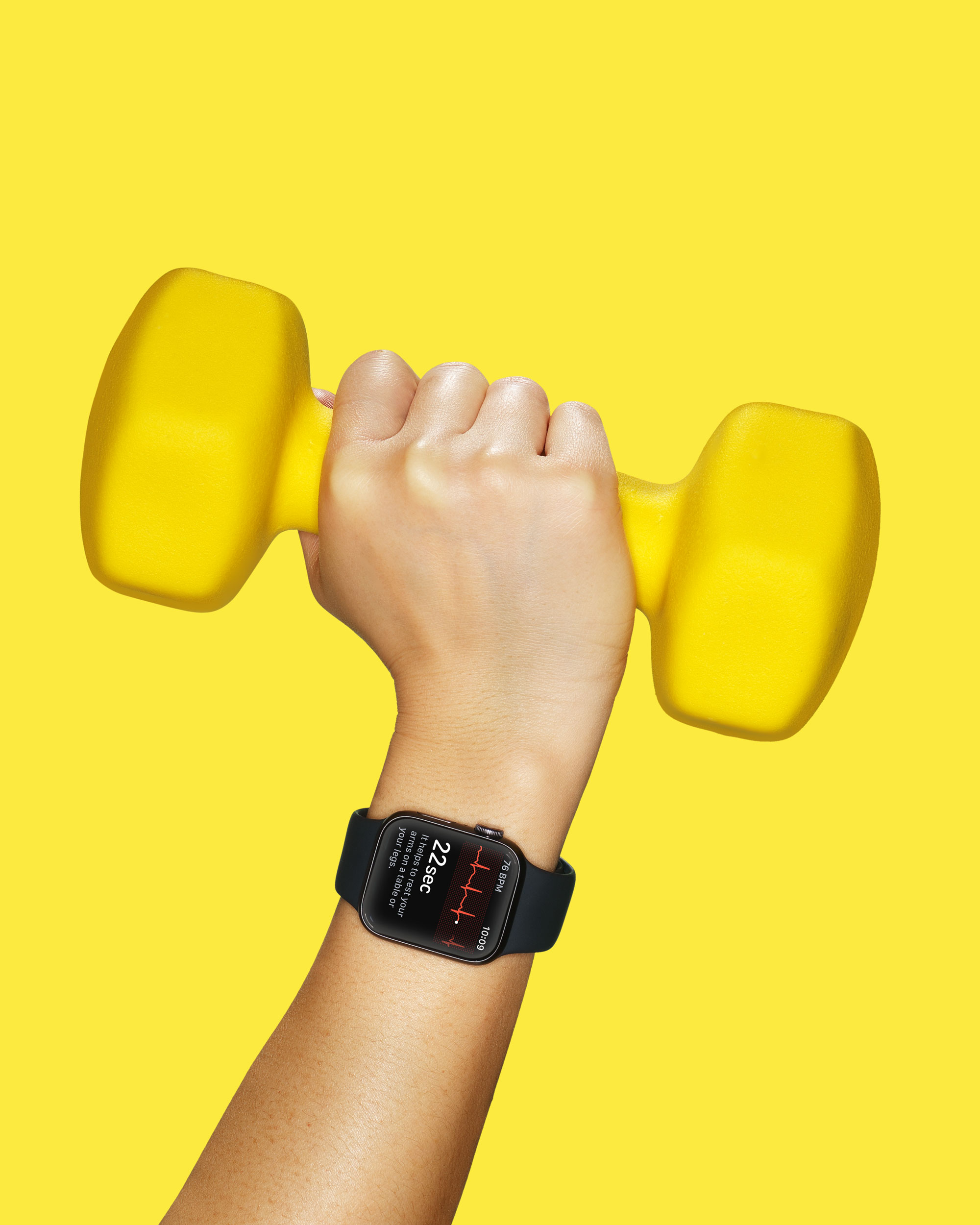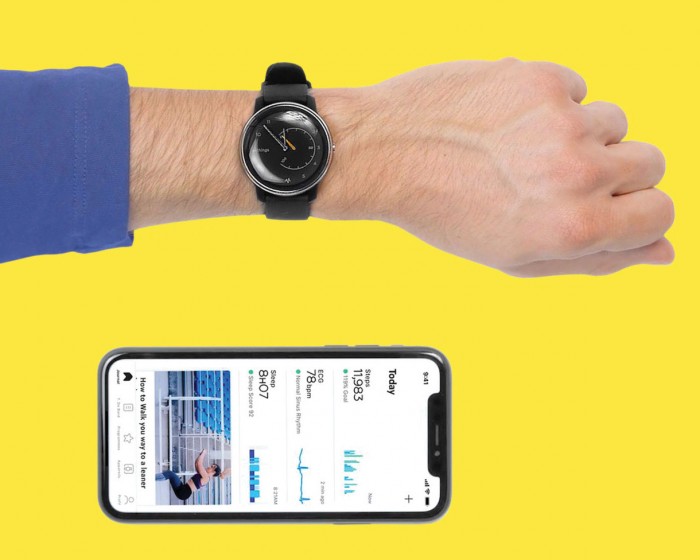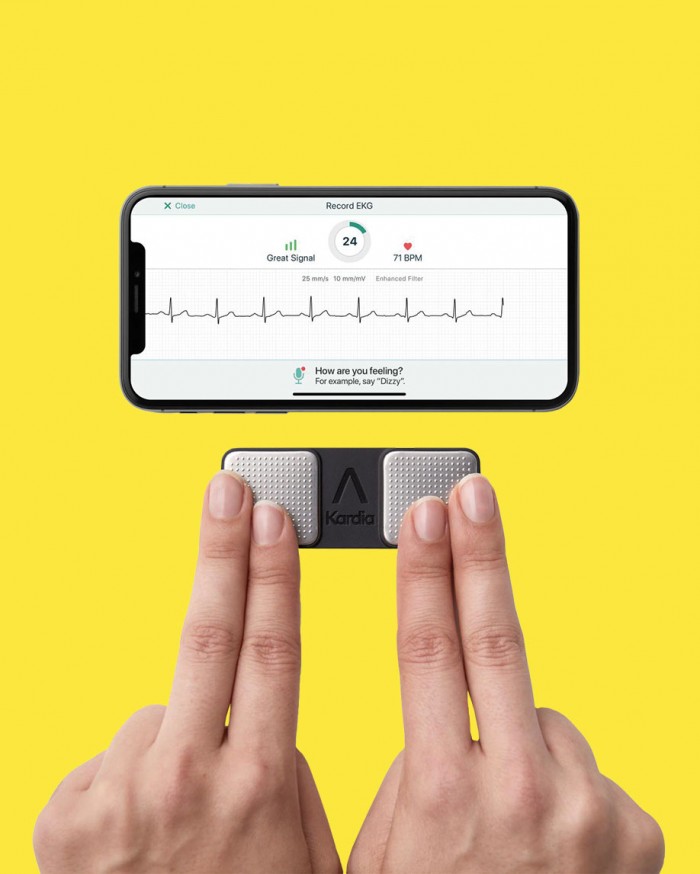Wristwatch heart monitors might save your life—and change medicine, too
Making complex heart tests available at the push of a button has far-reaching consequences.

It begins seven years ago, when my doctor asks me whether I want to lose my foot. I say to him: No, I do not want to lose my foot. “Good,” he says back: Monitor your blood sugar, keep it down, and we can manage this disease. Then nobody has to lose a foot.
It turns out I have type 2 diabetes, which—from a patient’s point of view—boils down to a single data point: the amount of glucose in my bloodstream. Low is good; high is bad. Threatening my feet felt like a scare tactic, but the results of an undetected infection are very real for diabetics. We are often hit by a grim combination of weaker immune response and loss of feeling in the limbs, which can make a routine infection go very, very bad. And, like all 30 million Americans who have been diagnosed with diabetes, I face other potential complications, too: kidney, retinal, gum, and heart disease, never mind a high incidence of depression (unsurprisingly, it can be depressing to learn that you might lose a foot).
But yes, it’s the foot that does it for me. That’s when I start collecting health data.
I realize that for my entire life, I haven’t paid much attention to my health. My body was just meat housing for my brain. Suddenly, with my FDA-approved glucose meter, I have a small device that tells me a number, and that number gives me a reason to care more about my body.
I begin to discover that it’s not just glucose I can monitor. A range of data and devices can help me avoid other health problems. High blood pressure, for example, affects 75 million Americans and the majority of diabetics. I’m also at higher risk of AFib—atrial fibrillation, or an irregular heartbeat, which can increase the chance that I have a stroke.
Gathering this new information requires a patchwork of services, so I approach it like an engineer. I track steps using wearable devices from Fitbit and Nike, and apps like Moves. I watch for high blood pressure with a Withings smart monitor. The data is stored alongside my weight, body fat percentage, and body mass index, all measured with a smart scale. And all the time there’s my blood glucose, measured six times a day, before and after each meal.
I export the data as CSVs and view it in hand-crafted graphs and dashboards. My ad hoc monitoring system makes me an early adopter, a bona fide member of the quantified-self movement.
Seven years later, though, my fringe obsession has become mainstream. My cobbled-together system has been replaced by Apple’s shiny Health app, and I get prompted to exercise by a wearable that is more powerful than my first laptop. And my watch can even monitor my heart.

I’ve been wearing an Apple Watch for the last 15 months, using it to meet activity goals and monitor my health. (“Dan, you’re so close to closing your Move ring. A brisk nine-minute walk should do it.”) But the Series 4, Apple’s latest model, has an extra function: a built-in electrocardiogram (ECG).
The gold-standard ECG measures the electrical activity of your heart with a 12-lead test, all wires and electrodes, administered by a medical professional. A watch that can run a basic version of this procedure—with a device you can wear all day, every day, for a price of a few hundred dollars—is a breakthrough.
Apple isn’t the first to produce an over-the-counter ECG reader. AliveCor, a medical-device startup based in Silicon Valley, got there first with two FDA-licensed consumer ECG devices: the $100 KardiaMobile and the $199 Apple Watch band accessory KardiaBand.
All these devices are now used mainly to screen for AFib. That’s a big deal, because not only do as many as 6.1 million Americans have the condition, but research suggests another 700,000 have irregular heartbeats that are undiagnosed. AFib contributes to an estimated 130,000 deaths each year in the US—but 20% of people whose strokes were due to AFib were unaware they had it until they were hospitalized. At the moment, even people with the best access to care get only two or three ECGs a year. Preventive screening could, if widely implemented, save thousands of lives.
Taking an ECG reading from a watch is a big step in that direction.
Not too much about the Series 4 feels different from the previous model— it’s a little faster, and instead of a red dot on the digital crown, this one has a red circle. There’s a rigorous tutorial that covers the notifications it can give me for irregular heart rhythms, and it takes me through the ECG app. Apple explains what an ECG is and, broadly, what it measures. It tells me the different results I might get, such as a normal heartbeat (known as sinus rhythm), AFib, and low or high heart rate. During setup, there are clean, easy-to-read screens telling me what the ECG can’t do: detect a heart attack, blood clots, or other conditions like high blood pressure or high cholesterol. If I’m not feeling well, it says, I should talk to my doctor. If I’m experiencing chest pain, I should call emergency services. It’s like the iTunes terms of service, but a lot shorter and much more serious.
Then it asks me to take a reading. This first time, I’m a little anxious. I remember that my mum has a history of hypertrophic cardiomyopathy, and my brother, too.
Apple Watch’s ECG works by forming a circuit that runs from the back of the watch, where it touches the skin on my left wrist, through to the watch’s crown, which I touch with a finger of my right hand. The app uses the electrical pulses running through this circuit to get my heart rate and, most important, to see if the upper and lower chambers of my heart are in rhythm. To take an ECG, I’ll have to sit still and keep that right-hand finger on the digital crown for 30 seconds.
It’s a long 30 seconds.
As the timer counts down, I feel the same anxiety mounting in my chest that I do when I have my blood pressure taken. I really want the upper and lower chambers of my heart to be in rhythm.
And then there it is, on my phone: “Setup Complete. This ECG does not show signs of atrial fibrillation.”
I give an audible sigh of relief, and realize I’ve been holding my breath.
Over the next few weeks, I take my ECG a couple more times, but the urgency and anxiety have worn off. The only time I get a non-uniform result is when our family arrives at the airport at the start of our vacation. This one seems fine: I’ve had a stressful morning, and all the subsequent readings I take are back to normal.
In a month wearing the Series 4 that was loaned to me by Apple, the experience has been mostly mundane. That’s probably how it’ll go for most people. For a good friend of mine, though, the watch made a more dramatic difference.
It wasn’t a surprise to hear that Tom had upgraded to the Series 4 when it came out. He’s been an Apple user longer than I have, and he has a family history of AFib on his mother’s side. (It turns out she already uses KardiaMobile, as well as hospital-style home monitoring.)
One day, while I was testing my own Apple Watch, Tom was deconstructing a rack of network equipment. He suddenly noticed his heart was pounding. Then he began feeling dizzy. Next came tunnel vision. He needed to sit down.
First he checked the pulse on his neck, but he realized his watch could provide more data. It said 203 beats per minute, so he fired up an ECG—the first time he’d done it, so he had to go through setup and onboarding first. When it took his reading, Tom’s watch said it couldn’t check for AFib because the heart rate was over 120 beats per minute: “If you’re not feeling well, you should talk to your doctor,” it said. Tom was definitely not feeling well, so he had a coworker take him to the hospital, where triage got him to a nurse straight away.
His nurse set up an ECG, the traditional “gold standard” kind, but Tom could feel that his heart rate had dropped closer to normal. He worried that the hospital test wouldn’t find anything, so he unlocked his phone and passed the readings to the nurse, who showed them to the remote teledoctor on call.
“Oh, that’s an SVT,” the doctor said, immediately. A supraventricular tachycardia: an abnormally fast heartbeat caused by irregular electrical activity. The hospital ordered blood tests and sent Tom to his regular doctor for a follow-up.
This sequence of events encapsulates the promise of having a “good enough” ECG on demand: readings can be taken when symptoms happen, not after. The right data at the right time.
But Tom’s experience feels fortuitous, too. What might have happened if Tom hadn’t taken an ECG, or if there hadn’t been a report for the doctor? Would the gold-standard hospital ECG have found anything?
Those questions are moot. Tom did have an ECG, taken within seconds of his symptoms. He had more tests, and they showed he’s got nothing to worry about for now. But he’s been alerted to the danger. It worked. He’s grateful.
Experience shows that when these devices are available, people use them. Fitbit devices now track more than 25 million active users. In early 2019, the connected-device maker Withings announced that its forthcoming watch will have an ECG reader. Apple alone sells millions of watches each year. Consumer ECGs are here, and they’re probably going to get cheaper and more ubiquitous.
These systems are creating a mountain of health data, though. How do we interpret this information? Can the medical profession cope with the volume? There is no excess of experienced cardiologists waiting to review the 20 million ECGs AliveCor recorded in 2017, and that was before Apple turned up.
It seems inevitable that we’ll throw deep-learning algorithms at the data and look for new ways to use it. Apple recently announced a study with Johnson & Johnson to screen for stroke risk. And AliveCor’s KardiaK software—developed through a partnership with the Mayo Clinic—has been granted accelerated clearance by the FDA. KardiaK uses deep learning on ECGs to screen for hyperkalemia, or elevated potassium levels in the blood. For people with kidney disease, the condition comes with a higher risk of arrhythmia and death.
For all the potential benefit, though, one could envision things getting quickly out of hand. In a few product cycles, anything from a $25 Xiaomi wearable to a high-end Apple Watch could be collecting a range of health information and using it to screen for conditions like hypertension, sleep apnea, diabetes, or even changes in mood. In a tired joke, I imagine a future continuously monitored by Microsoft’s Clippy: “It looks like you’re starting to get depressed. Would you like help getting some exercise?”
How prepared are we to deal with the ethical issues these predictive models create? How can the technologies be audited to make sure they work for all users and not, accidentally, just for subsets of populations? When we use this data—and it is when, not if—we need to be able to answer these questions, and others.

Seven years ago I started tracking my blood sugar because I didn’t want to lose a foot. Now, after a month of using the Series 4 Apple Watch, I’m reminded what data can mean for my heart and, by extension, my mind.
The red dot on the digital crown of my Series 3 Watch was comforting. It meant that I had cell coverage and wasn’t out of touch. Now, the red circle on the Series 4 feels even more reassuring—but in an entirely different way.
Dan Hon is a product strategist working on California’s digital services and an occasional technology writer based in Portland, Oregon.
Keep Reading
Most Popular
Large language models can do jaw-dropping things. But nobody knows exactly why.
And that's a problem. Figuring it out is one of the biggest scientific puzzles of our time and a crucial step towards controlling more powerful future models.
How scientists traced a mysterious covid case back to six toilets
When wastewater surveillance turns into a hunt for a single infected individual, the ethics get tricky.
The problem with plug-in hybrids? Their drivers.
Plug-in hybrids are often sold as a transition to EVs, but new data from Europe shows we’re still underestimating the emissions they produce.
Google DeepMind’s new generative model makes Super Mario–like games from scratch
Genie learns how to control games by watching hours and hours of video. It could help train next-gen robots too.
Stay connected
Get the latest updates from
MIT Technology Review
Discover special offers, top stories, upcoming events, and more.